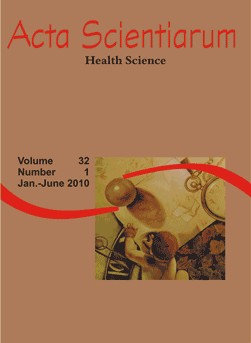<b>Evaluation of the chemical composition of <em>Cymbopogon citratus</em> Stapf growing in environments with different pollution levels and the influence on tea composition</b> - DOI: 10.4025/actascihealthsci.v32i1.4543
Keywords:
Cymbopogon citratus, stress, chemical composition, tea
Abstract
Cymbopogon citratus Stapf, popularly known as lemongrass, is an Indian species. It possibly arrived in Brazil during colonial times, where it was used as an ornamental plant, and is found growing throughout the country. There are several popular uses for this plant, including as treatment for stomach pains, diarrhea and cellulite. This plant grows in polluted and unpolluted environments such as roadsides, which can lead to changes in its chemical aspects, and consequently changes in its manufacturing products. This study examined whether there were changes in the chemical composition of plants grown in the presence or absence of environmental stress (urban pollution). The following compounds were studied, using thin layer chromatography: saponins, iridoids and proanthocyanidins, mono- and sesquiterpenes, triterpenes and steroids, flavonoids, polyphenols and alkaloids. It was concluded that this factor may have contributed to changes in the chemical composition of its leaves, reducing the synthesis of more polar compounds and promoting synthesis of possible leucoanthocyanidins for possible protection. This can lead to changes in the pharmacological and toxicological properties of tea.Downloads
Download data is not yet available.
Published
2009-12-07
How to Cite
Silva, M. A. L. da, Marques, G. S., Santos, T. M. F. dos, Xavier, H. S., Higino, J. S., & Melo, A. F. M. de. (2009). <b>Evaluation of the chemical composition of <em>Cymbopogon citratus</em> Stapf growing in environments with different pollution levels and the influence on tea composition</b> - DOI: 10.4025/actascihealthsci.v32i1.4543. Acta Scientiarum. Health Sciences, 32(1), 67-72. https://doi.org/10.4025/actascihealthsci.v32i1.4543
Issue
Section
Pharmacy
DECLARATION OF ORIGINALITY AND COPYRIGHTS
I Declare that current article is original and has not been submitted for publication, in part or in whole, to any other national or international journal.
The copyrights belong exclusively to the authors. Published content is licensed under Creative Commons Attribution 4.0 (CC BY 4.0) guidelines, which allows sharing (copy and distribution of the material in any medium or format) and adaptation (remix, transform, and build upon the material) for any purpose, even commercially, under the terms of attribution.
Read this link for further information on how to use CC BY 4.0 properly.























5.png)







